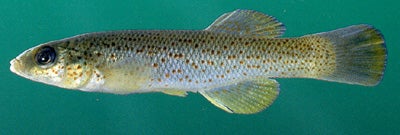SCIENTIFIC NAME: Fundulus stellifer
CHARACTERISTICS: Breeding males of the southern studfish are sky blue along the sides, white on the venter, and blue-brown on the back. Dark orange to orange-red spots are randomly scattered along the dorsolateral region and continue on the head, while spots on the peduncle may form primitive rows. The sides of Fundulus stellifer have a crosshatched appearance that extends to the base of the anal fin. The cheeks are white with flecks of blue, while the gill covers are flecked with gold. All fins are generally clear or yellow with rows of elongate orange spots in the dorsal fin and in the proximal halves of the caudal and anal fins. The caudal and dorsal fins may also have a black margin. A member of the subgenus Xenisma, the southern studfish is most closely related to F. catenatus and F. bifax, the northern studfish and stippled studfish. See Jordan (1877a) for original description.
ADULT SIZE: 2.2 to 3.9 in (56 to 100 mm)
DISTRIBUTION: Most collections of this species are from the Coosa River system above the Fall Line. An isolated population exists in the lower Alabama River drainage where the river divides the lower Southern Red Hills and Lime Hills regions. Our failure to collect additional specimens from previous sampling localities may indicate that this species has been extirpated from the Cahaba River system. Fundulus stellifer is replaced in the Tallapoosa River system by F. bifax (Cashner et. al., 1988).
HABITAT AND BIOLOGY: This species is found in small or medium upland streams around pools and quiet shallow areas. It also occurs in pool areas of large steams and rivers. Nuptial individuals have been collected from undercut banks with extensive structure, and spawning occurs from late spring to early summer. Although no one has completed a study of the feeding biology of this species, its diet is believed to be similar to that of F. catenatus, consisting of terrestrial insects, crustaceans, snails, and bivalve mollusks. However, Thomerson (1969) reports that F. stelifer and F. catenatus have different pharyngeal bone and tooth structures; F. stellifer"s larger crushing teeth are possibly correlated with its diet of mollusks and crustaceans.
REMARKS: The type locality for the southern studfish is tributaries to the Etowah, Oostanaula, and Coosa rivers in Georgia.
ORIGINAL DESCRIPTION: Jordan described the southern studfish in 1877.
ETYMOLOGY:
Fundulus means bottom.
Stellifer means star bearer.
The copyrighted information above is from Fishes of Alabama and the Mobile Basin.






